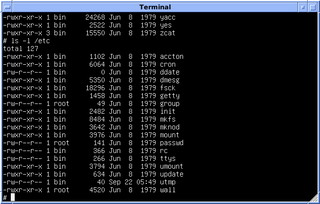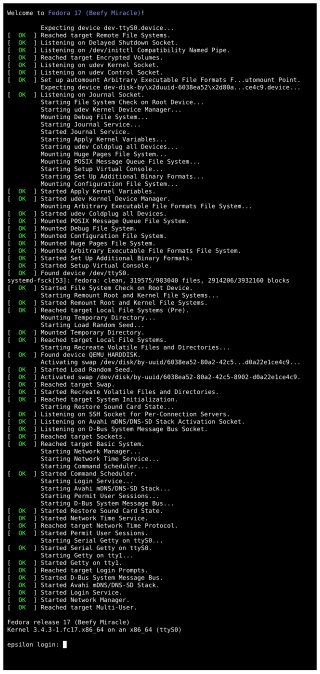Related Research Articles

The X Display Manager (XDM) is the default display manager for the X Window System. It is a bare-bones X display manager. It was introduced with X11 Release 3 in October 1988, to support the standalone X terminals that were just coming onto the market. It was written by Keith Packard.
freedesktop.org (fd.o), formerly X Desktop Group (XDG), is a project to work on interoperability and shared base technology for free-software desktop environments for the X Window System (X11) and Wayland on Linux and other Unix-like operating systems. Although freedesktop.org produces specifications for interoperability, it is not a formal standards body.

In multitasking computer operating systems, a daemon is a computer program that runs as a background process, rather than being under the direct control of an interactive user. Traditionally, the process names of a daemon end with the letter d, for clarification that the process is in fact a daemon, and for differentiation between a daemon and a normal computer program. For example, syslogd is a daemon that implements system logging facility, and sshd is a daemon that serves incoming SSH connections.
The Berkeley r-commands are a suite of computer programs designed to enable users of one Unix system to log in or issue commands to another Unix computer via TCP/IP computer network. The r-commands were developed in 1982 by the Computer Systems Research Group at the University of California, Berkeley, based on an early implementation of TCP/IP.
A runlevel is a mode of operation in the computer operating systems that implements Unix System V-style initialization. Conventionally, seven runlevels exist, numbered from zero to six. S is sometimes used as a synonym for one of the levels. Only one runlevel is executed on startup; run levels are not executed one after another.
udev is a device manager for the Linux kernel. As the successor of devfsd and hotplug, udev primarily manages device nodes in the /dev directory. At the same time, udev also handles all user space events raised when hardware devices are added into the system or removed from it, including firmware loading as required by certain devices.

In the X Window System, an X display manager is a graphical login manager which starts a login session on an X server from the same or another computer.

In Unix-based computer operating systems, init is the first process started during booting of the operating system. Init is a daemon process that continues running until the system is shut down. It is the direct or indirect ancestor of all other processes and automatically adopts all orphaned processes. Init is started by the kernel during the booting process; a kernel panic will occur if the kernel is unable to start it, or it should die for any reason. Init is typically assigned process identifier 1.
D-Bus is a message-oriented middleware mechanism that allows communication between multiple processes running concurrently on the same machine. D-Bus was developed as part of the freedesktop.org project, initiated by GNOME developer Havoc Pennington to standardize services provided by Linux desktop environments such as GNOME and KDE.

NetworkManager is a daemon that sits on top of libudev and other Linux kernel interfaces and provides a high-level interface for the configuration of the network interfaces.

A multiseat, multi-station or multiterminal system is a single computer which supports multiple independent local users at the same time.
HAL is a software subsystem for UNIX-like operating systems providing hardware abstraction.
getty, short for "get tty", is a Unix program running on a host computer that manages physical or virtual terminals (TTYs). When it detects a connection, it prompts for a username and runs the 'login' program to authenticate the user.
The multi-stage booting process of Linux is in many ways similar to the BSD and other Unix-style boot processes, from which it derives.

Polkit is a component for controlling system-wide privileges in Unix-like operating systems. It provides an organized way for non-privileged processes to communicate with privileged ones. Polkit allows a level of control of centralized system policy. It is developed and maintained by David Zeuthen from Red Hat and hosted by the freedesktop.org project. It is published as free software under the terms of version 2 of the GNU Lesser General Public License.
GVfs is GNOME's userspace virtual filesystem designed to work with the I/O abstraction of GIO, a library available in GLib since version 2.15.1. It installs several modules that are automatically used by applications using the APIs of libgio. There is also FUSE support that allows applications not using GIO to access the GVfs filesystems.

The Linux console is a system console internal to the Linux kernel. A system console is the device which receives all kernel messages and warnings and which allows logins in single user mode. The Linux console provides a way for the kernel and other processes to send text output to the user, and to receive text input from the user. The user typically enters text with a computer keyboard and reads the output text on a computer monitor. The Linux kernel supports virtual consoles – consoles that are logically separate, but which access the same physical keyboard and display. The Linux console are implemented by the VT subsystem of the Linux kernel, and do not rely on any user space software. This is in contrast to a terminal emulator, which is a user space process that emulates a terminal, and is typically used in a graphical display environment.

systemd is a software suite that provides an array of system components for Linux operating systems. The main aim is to unify service configuration and behavior across Linux distributions. Its primary component is a "system and service manager" – an init system used to bootstrap user space and manage user processes. It also provides replacements for various daemons and utilities, including device management, login management, network connection management, and event logging. The name systemd adheres to the Unix convention of naming daemons by appending the letter d. It also plays on the term "System D", which refers to a person's ability to adapt quickly and improvise to solve problems.

Kmscon is a virtual console that runs in userspace which David Hermann created to replace the Linux console, a terminal built into the Linux kernel. Kmscon uses the KMS driver for its output, it is multiseat-capable, and supports internationalized keyboard input and UTF-8 terminal output. The input support is implemented using X keyboard extension (XKB). Development of Kmscon stopped in March 2015. There was a successor project called systemd-consoled, but this project was also later dropped in July 2015.

UPower is a piece of middleware for power management on Linux systems. It enumerates power sources, maintains statistics and history data on them and notifies about status changes. It consists of a daemon (upowerd), an application programming interface and a set of command line tools. The daemon provides its functionality to applications over the system bus. PolicyKit restricts access to the UPower functionality for initiating hibernate mode or shutting down the operating system (freedesktop.upower.policy). The command-line client program upower can be used to query and monitor information about the power supply devices in the system. Graphical user interfaces to the functionality of UPower include the GNOME Power Manager and the Xfce Power Manager.
References
- ↑ "Configuring Login Manager". Solaris Common Desktop Environment: Advanced User's and System Administrator's Guide. Palo Alto: Sun Microsystems. 2000. Retrieved 26 July 2013.
- ↑ "Display Manager". ArchWiki. Arch Linux. 23 July 2005. Retrieved 26 July 2013.
- ↑ "systemd-logind.service". www.freedesktop.org. Retrieved 2023-11-08.
- ↑ "ConsoleKit". www.freedesktop.org. Retrieved 2023-11-08.